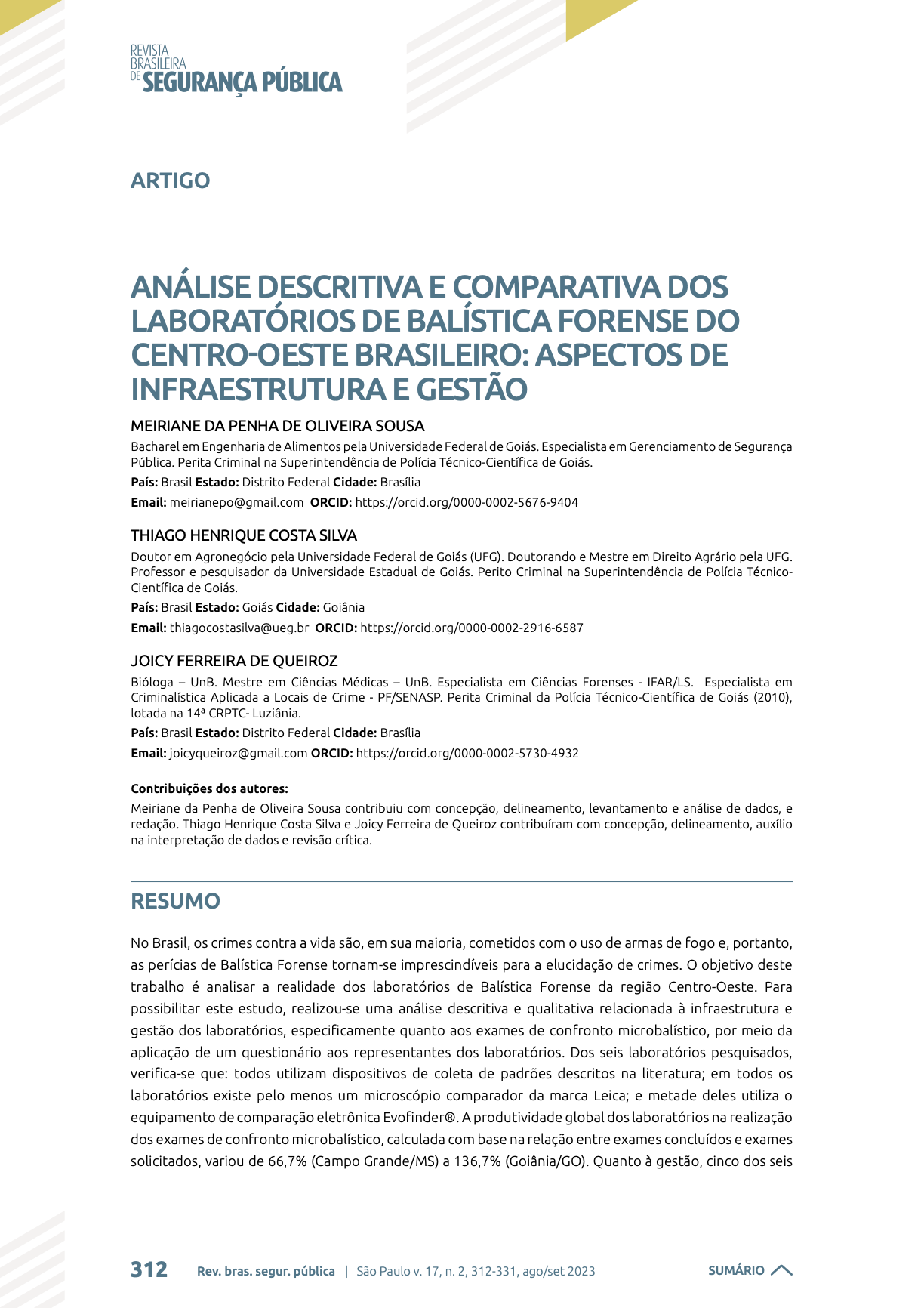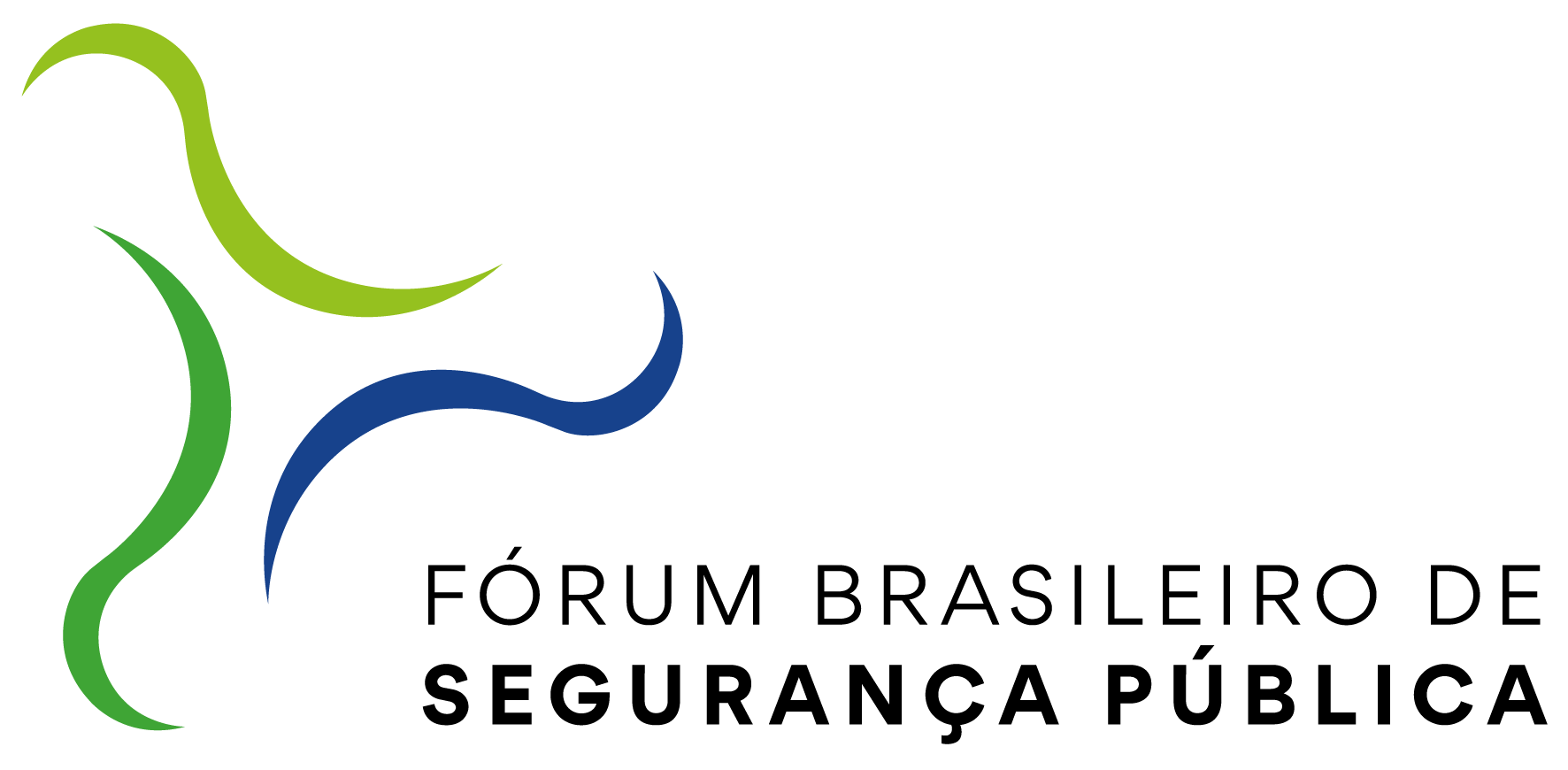Descriptive and comparative analysis of forensic ballistic laboratories in brazilian midwest
aspects of infrastructure and management
DOI:
https://doi.org/10.31060/rbsp.2023.v17.n2.1676Keywords:
Criminal expertise, Infrastructure, Microballistic confrontation, Productivity, Management toolsAbstract
In Brazil, crimes against life are mostly committed with firearms. Thus, the skills of Forensic Ballistics become essential for the elucidation of crimes. The objective of this work is to analyze the reality of Forensic Ballistics laboratories in the Brazilian Midwest region. To do this study, a descriptive and qualitative analysis, about the infrastructure and management of the laboratories, was carried out, specifically regarding the microballistic confrontation tests, through the application of a questionnaire to the laboratory’s representatives. Among the six laboratories surveyed, it was found that: all use pattern collection devices described in the literature; in all laboratories there is at least one Leica comparator microscope; and half of them use Evofinder® electronic comparison equipment. The overall productivity of laboratories in performing microballistic tests, calculated on the basis of the ratio between completed tests and requested tests, ranged from 66.7% (Campo Grande/MS) to 136.7% (Goiânia/GO). As for management, a criminal expert coordinates five of the six laboratories. Of these, four claimed to use some productivity monitoring tool, however, only one uses specific management tools in their routine. It is concluded that there is a need for greater investments in forensic ballistics laboratories, especially in personnel and management tools, in order to improve the results provided to the population.
Downloads
References
BRASIL. Congresso Nacional. Lei Nº 10.826, de 22 de dezembro de 2003. Dispõe sobre registro, posse e comercialização de armas de fogo e munição, sobre o Sistema Nacional de Armas – Sinarm, define crimes e dá outras providências. Brasília/DF: Diário Oficial da União, Seção 1, p. 1, 23 dez. 2003.
BRASIL. Secretaria Nacional de Segurança Pública. Balística Forense. In: BRASIL. Secretaria Nacional de Segurança Pública. Procedimento operacional padrão: perícia criminal. Brasília: Ministério da Justiça, Secretaria Nacional de Segurança Pública, 2013. Cap. 1, p. 1-53.
BRASIL. Congresso Nacional. Lei Nº 13.964, de 24 de dezembro de 2019. Aperfeiçoa a legislação penal e processual penal. Brasília/DF: Diário Oficial da União, Seção 1, Extra A, p. 1, 24 dez. 2019.
BRASIL. Ministério da Justiça e Segurança Pública. Pregão Eletrônico Internacional Nº 22/2020 – Sistema Nacional de Balística – SINAB. Processo Administrativo Nº 08020.008738/2019-15. Data da abertura: 16 out. 2020.
BRASIL. Executivo. Decreto Nº 10.711, de 2 de junho de 2021. Institui o Banco Nacional de Perfis Balísticos, o Sistema Nacional de Análise Balística e o Comitê Gestor do Sistema Nacional de Análise Balística. Brasília/DF: Diário Oficial da União, Seção 1, Extra B, ed. 103-B, p. 4, 2 jun. 2021.
CERQUEIRA, D.; BUENO, S. (Coords.). Armas de fogo. In: CERQUEIRA, D.; BUENO, S. (Coords.). Atlas da Violência 2020. Brasília: Rio de Janeiro: São Paulo: Instituto de Pesquisa Econômica Aplicada – Ipea; Fórum Brasileiro de Segurança Pública – FBSP, 2020, p. 73-79.
CHEW, W. B. No-nonsense guide to measuring productivity. Harvard Business Review, Operations Strategy, jan. 1988.
COSTA NETO, R. P. C.; SILVA, L. M.; OLIVEIRA, F. S. G.; ALVARES, F. H. B. Gestão da produtividade total: definição de produtividade a partir de sete constatações. Revista de Engenharia da Universidade Católica de Petrópolis, Petrópolis/RJ, v. 7, n. 2, p. 83-94, 2012.
DANIEL, E. A.; MURBACK, F. G. R. Levantamento bibliográfico do uso das ferramentas da qualidade. Gestão & Conhecimento, Art. 8, 2014.
DIAS, E. P. Conceitos de gestão e administração: uma revisão crítica. Revista Eletrônica de Administração, Franca/SP, v. 1, n. 1, p. 1-12, jul./dez. 2002.
ERDMANN, R. H. Gestão da qualidade no setor público. 3 ed. ver. atual. Florianópolis: Departamento de Ciências da Administração / UFSC; [Brasília]: CAPES: UAB, 2016.
FIGUEIREDO, I.; MARQUES, I. Panorama sobre as armas de fogo no Brasil: um retrato possível a partir dos sistemas federais. In: FÓRUM BRASILEIRO DE SEGURANÇA PÚBLICA – FBSP. Anuário Brasileiro de Segurança Pública 2021. São Paulo: FBSP, 2021, p. 144-148.
FÓRUM BRASILEIRO DE SEGURANÇA PÚBLICA – FBSP. Anuário Brasileiro de Segurança Pública 2020. São Paulo: FBSP, 2020.
GERERE. In: Dicionário Etimológico [online]: Etimologia e Origem das Palavras. [s.d.].
LIMA, R. S.; BUENO, S.; ALCADIPANI, R. Evolução das mortes violentas intencionais no Brasil. In: FÓRUM BRASILEIRO DE SEGURANÇA PÚBLICA – FBSP. Anuário Brasileiro de Segurança Pública 2021. São Paulo: FBSP, 2021, p. 21-35.
MARSHALL, I. J.; CIERCO, A. A.; ROCHA, A. V.; MOTA, E. B.; LEUSIN, S. Gestão da qualidade. 9 ed. Rio de Janeiro: FGV, 2008.
NAKAGAWA, M. Ferramenta: 5W2H – Plano de ação para empreendedores. Sebrae, Estratégia e Gestão, 2017.
NOBRE, F. C.; CORRÊA, D. A.; NEPOMUCENO, L. H.; NOBRE, L. H. N.; SOUSA, A. J.; SIQUEIRA, V. A amostragem na pesquisa de natureza científica em um campo multiparadigmático: peculiaridades do método qualitativo. Espacios, v. 38, n. 22, 2017.
PROJECT MANAGEMENT INSTITUTE – PMI. Guia do conhecimento em gerenciamento de projetos. Guia PMBOK®. 6 ed. EUA: Project Management Institute, 2017.
RABIN, J.; HILDRETH, W. B.; MILLER, G. J. (Eds.). Handbook of public administration. 3 ed. Florida: Taylor & Francis Group, 2007.
RAMOS, D. Sistema Nacional de Análise Balística (SINAB) será implementado com 37 equipamentos no país. Perícia Federal, ano XVI, n. 46, p. 22-28, dez. 2020.
SANTOS, L. S. Avaliação de Parâmetros que afetam a efetividade da Comparação Balística Automatizada. Dissertação (Mestrado em Ciências Mecânicas) – Departamento de Engenharia Mecânica, Faculdade de Tecnologia, Universidade de Brasília, Brasília/DF, 2015. 139 p.
SANTOS, L. S. The influence of firearms and ammunition properties on the effectiveness of automated ballistic correlations. Tese (Doutorado em Ciências Mecânicas) – Departamento de Engenharia Mecânica, Faculdade de Tecnologia, Universidade de Brasília, Brasília/DF, 2020. 303 p.
TOCCHETTO, D. Balística forense: aspectos técnicos e jurídicos. 11 ed. Campinas: Millennium, 2021.
TOLEDO, J. C.; BORRÁS, M. A. A.; MERGULHÃO, R. C.; MENDES, G. H. S. Qualidade – gestão e métodos. Rio de Janeiro: LTC, 2013.
VENTURA, K. S.; SUQUISAQUI, A. B. V. Aplicação de ferramentas SWOT e 5W2H para análise de consórcios intermunicipais de resíduos sólidos urbanos. Ambiente Construído, Porto Alegre, v. 20, n. 1, p. 333-349, 2019.
WERKEMA, C. Métodos PDCA e DMAIC e suas ferramentas analíticas. Rio de Janeiro. Elsevier, 2013.

Published
How to Cite
Issue
Section
License
Copyright (c) 2023 Revista Brasileira de Segurança Pública

This work is licensed under a Creative Commons Attribution 4.0 International License.
Licensing
The Brazilian Journal of Public Security uses the Creative Commons License as a form of licensing for its published works. The license used follows the CC BY 4.0 - Attribution 4.0 International model.
To see the permitted rights please go to the full licence or to our Copyright and Licensing page.


